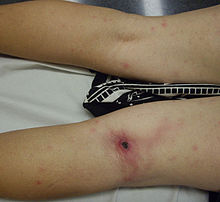
Back Crosta (coagulación) AN خشارة Arabic Crosta Catalan Strup (medicína) Czech Costra (medicina) Spanish Zarakar (medikuntza) Basque Rupi Finnish Eskaro IO Escara Italian かさぶた Japanese
An eschar (/ˈɛskɑːr/; Greek: ἐσχάρᾱ, romanized: eskhara; Latin: eschara) is a slough[1] or piece of dead tissue that is cast off from the surface of the skin, particularly after a burn injury, but also seen in gangrene, ulcer, fungal infections, necrotizing spider bite wounds, tick bites associated with spotted fevers and exposure to cutaneous anthrax. The term ‘eschar’ is not interchangeable with ‘scab’. An eschar contains necrotic tissue whereas a scab is composed of dried blood and exudate.

Black eschars are most frequently attributed in medicine to cutaneous anthrax (infection by Bacillus anthracis), which may be contracted through herd animal exposure and also from Pasteurella multocida exposure in cats and rabbits. A newly identified human rickettsial infection, R. parkeri rickettsiosis, can be differentiated from Rocky Mountain spotted fever by the presence of an eschar at the site of inoculation.[2] Eschar is sometimes called a black wound because the wound is covered with thick, dry, black necrotic tissue.
Eschar may be allowed to slough off naturally, or it may require surgical removal (debridement) to prevent infection, especially in immunocompromised patients (e.g. if a skin graft is to be conducted).
If eschar is on a limb, it is important to assess peripheral pulses of the affected limb to make sure blood and lymphatic circulation is not compromised. If circulation is compromised, an escharotomy, or surgical incision through the eschar, may be indicated.
- ^ "eschar" at Dorland's Medical Dictionary
- ^ Paddock, C. D.; Finley, R. W.; Wright, C. S.; Robinson, H. N.; Schrodt, B. J.; Lane, C. C.; Ekenna, O.; Blass, M. A.; Tamminga, C. L.; Ohl, C. A.; McLellan, S. L. F.; Goddard, J.; Holman, R. C.; Openshaw, J. J.; Sumner, J. W.; Zaki, S. R.; Eremeeva, M. E. (2008). "Rickettsia parkeri Rickettsiosis and Its Clinical Distinction from Rocky Mountain Spotted Fever". Clinical Infectious Diseases. 47 (9): 1188–1196. doi:10.1086/592254. PMID 18808353.